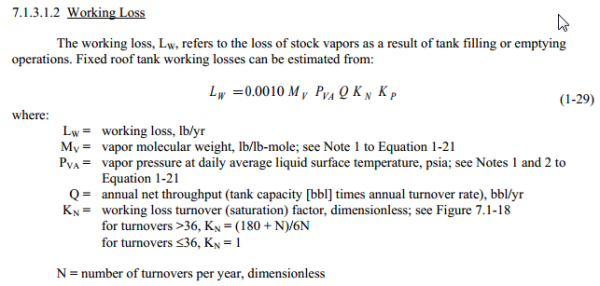.webp?width=320&name=cylinder%20(1).webp) One of the most common topics ERA’s environmental research team is asked to explain is the ins and outs of tank emissions management reporting. So much so that ERA’s head consultant recently gave a presentation on it at a national conference. It covered working and standing loss emissions from different types of tanks, and shed light on some of the more complex scenarios, like hot and heated tanks, and tank degassing.
One of the most common topics ERA’s environmental research team is asked to explain is the ins and outs of tank emissions management reporting. So much so that ERA’s head consultant recently gave a presentation on it at a national conference. It covered working and standing loss emissions from different types of tanks, and shed light on some of the more complex scenarios, like hot and heated tanks, and tank degassing.
It was so informative that we’ve decided to share this version of it with our blog readers. We’re sure you’ll find it helpful. Be sure to subscribe to our blog to get more in-depth articles about tank EHS management.
At the end of this article we're providing a free guide to some of the most complex storage tank emission calculations that you'll find in this article. Be sure to download your copy today.
Emissions: Tank Content & Characteristics
Simply put, emissions generated by your storage tanks are affected by two factors: how you use your tanks (contents) and what types of tanks you use (characteristics)
These two factors determine vapor pressure. And it's vapor pressure that's tied to the main storage tanks emissions: standing losses and working losses.
More specifically, a tank’s individual characteristics can have a significant impact on generated emissions. Even the less obvious characteristics. For example, the color of your tank affects heat absorption, and increases or decreases vapor pressure within the tank. Lighter colors will absorb less heat than dark ones.
One of the most vital tank characteristics is the roof type. The most common types are floating-roofs and fixed-roofs. Fixed roofs are permanently affixed to the top of the tank, which creates a great deal more space for vapors to accumulate when the tank is less than full. The less material in the tank, the more room for vapors to build up.
Floating-roofs float on the top of the material, guided by support legs and sealed with vapor seals around the rim. This means that there is little to no vapor space between the liquid surface and the roof. This greatly reduced emission generation compared to fixed-roof tanks. Floating-roof tanks can be internal or external: internal floating-roofs have a secondary fixed roof at the top of the tank to protect the floating element from rain and other outside contamination. External floating-roofs are exposed to the air and may be exposed to elements which may cause the roof to sink.
There are many possible combinations of tank characteristics, meaning that the exact same material in the exact same location stored in two different tanks will generate emission-laden vapors at different rates.
Working Losses: Loading, Unloading, and Roof Types
Working losses is the category of emissions that are generated and released while a liquid material is being pumped into or out of a tank. The movement of the fluid, particularly the turbulence created from splashing in or out of fill pipes, creates airborne vapors that must be managed.
In addition to liquid movement generating emissions, and time the tank is made into an open system in order to fill or withdraw liquid from it, there is the opportunity for vapors that have built up in between operations to escape into the atmosphere. In most cases, tank owners attach some type of control system or vapor recovery unit system to recapture some of these working loss emissions before they enter the atmosphere.
Depending on how you load your tank, your emissions will vary. There are two main types of loading: Splash and Submerged. Splash, as the name implies creates more turbulence and therefore more emissions. Submerged loading reduces turbulence and emissions. ERA has an entire article dedicated to more closely examining the difference between splash and submerged loading processes.
Working loss-related emissions escape from the tank being loaded or withdrawn from through different routes depending on the tank’s roof type. A fixed-roof tank releases emissions through a vapor vent as liquid is pushed into the tank, displacing any built-up vapors.
A floating-roof tank releases emissions whenever a liquid is withdrawn from the tank due to clingage loss. As the liquid surface level lowers, so too does the floating-roof. Liquid clinging to the wet tank shell, now exposed, evaporate and release emissions up out of the tank. If the floating-roof tank is internal (meaning there’s a fixed roof at the top of the tank above the floating-roof) these vapors will build up in the empty space rather than escape directly into the air. Clingage loss can also occur from other parts of the shell that were submerged, such as the roof’s guide legs.
Standing Losses: Breathing and Heat Expansion
Both types of tanks also generate emissions during times when there are no loading or unloading operations taking place. The petrochemical liquids in tanks are always generating vapors, depending on how much vapor space is available within the tank, and sometimes these vapors can escape the closed system of the tank - known as breathing losses.
For fixed-roof tanks, liquid level matters significantly for emission generation: the emptier the tank is, the more room there is for vapors to build up. However, it’s not until those vapors are pushed outwards with enough force to pass through the roof vent that these vapors become fugitive emissions.
Temperature variations in the tank’s location will cause the petrochemical gases to expand. The expansion of the gas raises the vapor pressure inside the tank, and that resulting pressure forces some of the built-up vapors out through the vent. This is why a tank that experiences fewer variations in temperature (a stable vapor pressure) or one that absorbs less heat (a lighter color or more reflective material) releases a lower quantity of emissions.
For floating-roof tanks, there is little-to-no room for vapors to build up under the roof. However, that smaller amount of vapors can escape out through rim seals, deck fittings, and deck seams when changes in temperature increase vapor pressure within the tank. When it comes to calculating these emissions, you will need to determine the efficiency of your rim seals and other emission control systems.
Controlling the Heat: How Heated Tanks Reduce Emissions
Temperature plays a huge role in the emissions forced out of tanks. The more variation in temperature, the more emissions you need to control for.
That’s where entirely different tank types come into play: hot and heated tanks.
Hot tanks are tanks used to store hot petrochemical liquids at a certain temperature and allow them to slowly cool. Heated tanks are tanks that are physically maintained at a specific temperature to keep materials at a consistent temperature. If a tank is sufficiently insulated and temperature-controlled, the thermal exchange with the ambient surrounds is negligible. In this case, you can assume that all internal regions of the tank are at the same temperature, meaning that there is no change in vapor pressure. When no change in vapor pressure occurs, there is no creation of breathing losses.
Surprisingly, there is little literature on documentation outlining the concept that insulated and heated tanks can be used to eliminate breathing losses.
The emissions calculations based on AP-42 guidelines for this type of tank is as follows:
TB = TL therefore no change in TV
Where:
TV - daily vapor temperature
TB - liquid bulk temperature
TL - liquid service temperature
If the liquid bulk temperature is maintained at a constant temperature, then no breathing loss occurs (no standing losses). Change in TV = 0, meaning no vapor expansion.
Cleaning and Degassing: Emissions from Cleaning and Maintenance
Cleaning and degassing your tanks will also contribute to your annual reportable emissions. In the process of cleaning a tank so that an entirely new product can be stored, some quantity of built-up vapors is forced out of the tank into the atmosphere. Degassing, in which you remove vapors from a tank to perform some type of maintenance or cleaning, can also release dangerous air pollutants to the atmosphere.
Cleaning
Cleaning a tank out entirely before a new material can be loaded into it will release some of the built-up vapors into the atmosphere, but not at every stage of the process.
First, as much of the tank’s liquid as possible is removed from the tank. Fresh air will be sucked into the tank at this stage, and so you should assume no emissions escape. Then the tank’s vents are shut off for a period of standing idle. At this time the small amount of liquid releases its vapors, which collect in the tank.
The next step is a vapor space purge, during which the vapors generated are forced out via forced ventilation. This is when emissions will escape the tank. At the same time, the remaining sludge is physically removed from the tank, creating sludge waste, which should also be tracked.
Once the tank is clean, there will be no more emissions in the tank until the a new material is loaded.
Degassing
Degassing is the forced removal of vapors from a tank in preparation for or during cleaning, typically done to tanks storing gasoline or crude oil. The methodology used to calculate emissions from degassing (degassing losses) depend on the type of tank being degassed:
For fixed-roof tanks you should calculate emissions for one turnover by using Kn = 1 in your calculation to account for vapors displaced during the tank’s filling. Then add emissions from one turnover calculation as if the tank had a floating roof to account for clingage. Here’s the generic calculation from the AP-42:

For floating-roof tanks you should calculate the emissions for one turnover, then add the emissions from the tank assuming the tank has a fixed roof with a height equal to the floating roof’s guide legs in order to approximate the vapor displaced from the space under the floating roof. You can find the base calculations for floating-roof tanks in chapter 7 of the AP-42.
Mobile Tanks: Truck, Railcar, and Marine Tanks
Even though the bulk of this article outlines emissions for stationary tank sources, your business must also account for emissions generated and released by your mobile sources - those trucks, railcars, and even marine vessels that transport and load/unload materials between tanks.
The primary emissions from mobile tanks are loading losses. When a mobile tank transports a material, vapors gets built up inside the tank. These vapors are composed of evaporation from previous loads, vapors transferred into the tank by vapor balance systems, and emissions generated from a new material being loaded.
These vapors are generally not released until the tank is later loaded up with a new material, displacing the vapors outwards. Even a mobile tank appearing “empty” can be full of vapors from its previous cargo. In fact, all of the following characteristics will affect the quantity and type of emissions released from a mobile tank:
-
Physical and chemical characteristics of the previous cargo
-
method of unloading the previous cargo
-
operations to transport the empty carrier to a loading terminal
-
method of loading the new cargo
-
physical and chemical characteristics of the new cargo
Tank EHS management is no easy feat, as proved by the complexity of the calculations and different factors you’ll need to account for. The easiest way to manage all of this is with a centralized EHS tracking and reporting platform designed with all the features specific to the Oil & Gas and Chemical industries. We also recommend subscribing to this blog to get the latest in-depth articles about tank EHS management.
ERA is offering a free guide to some of the most complex emission calculations that we've talked about in this article. It is a must read for anyone responsible for tracking and reporting emissions from their storage tanks. Click the button below now to get your free copy.
Ask an ERA Expert:
Do you have any questions or concerns about the topic covered in this article? Want more insight? Now is your chance to ask one of ERA’s Environmental Specialists. Please leave your question or comment below and we’ll make sure one of our expert scientists responds.
This Blog was Co-Authored By:


Tags:
Air Management
September 12, 2014

Comments